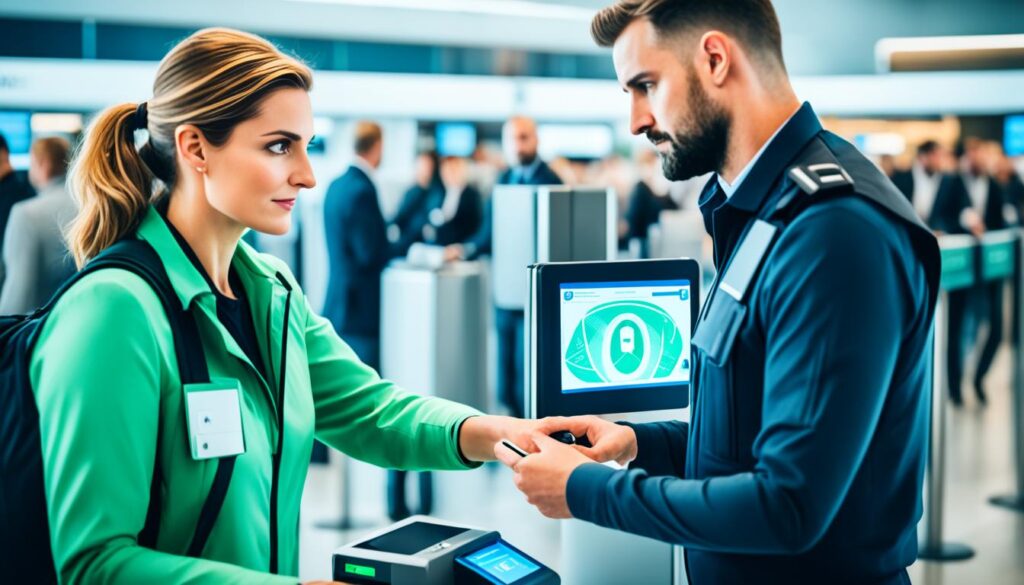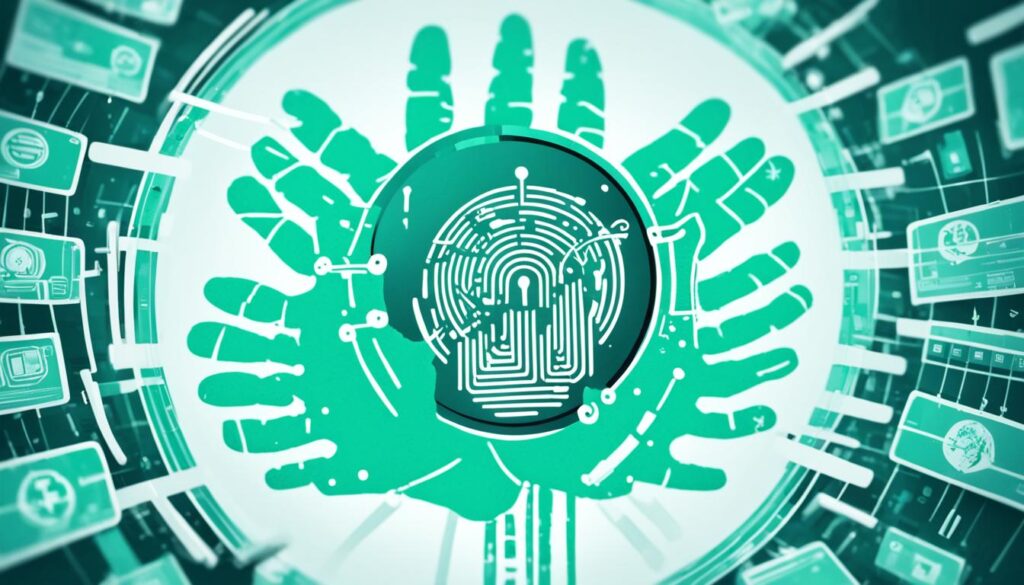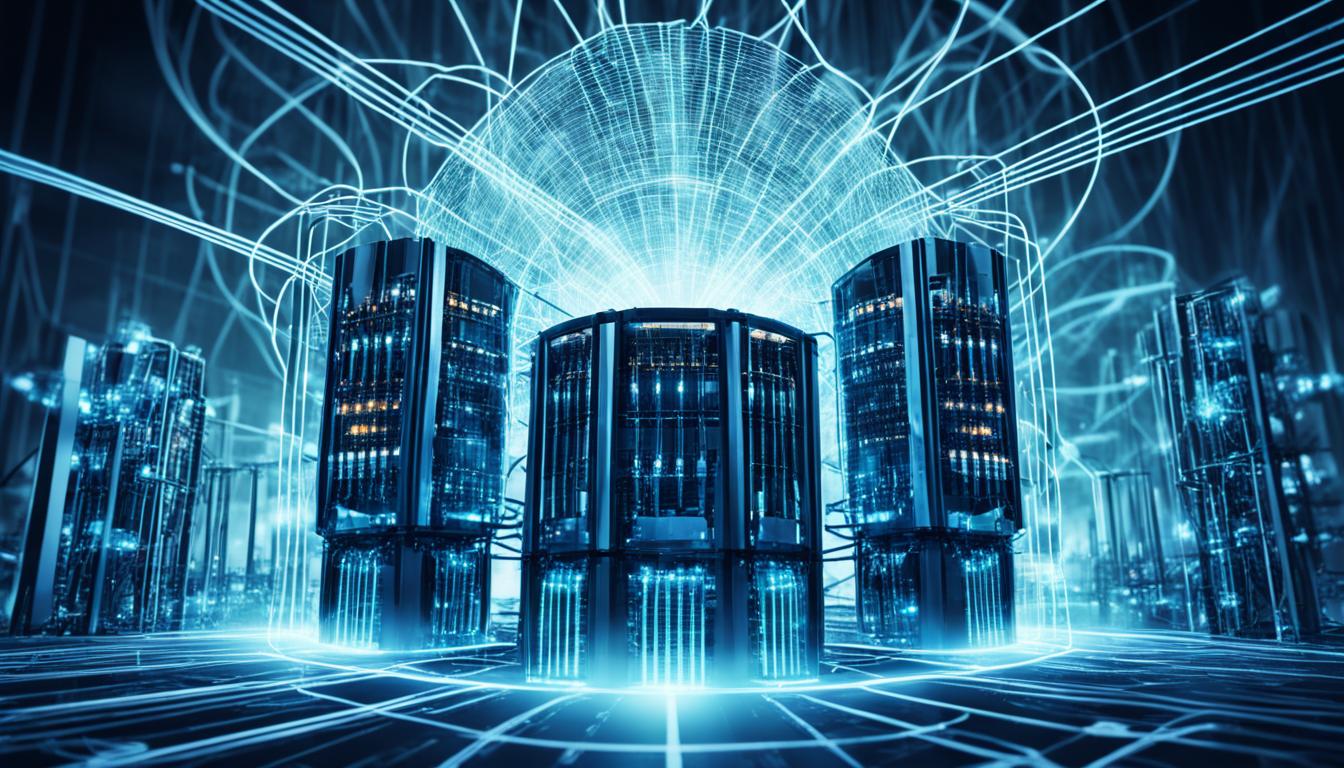Did you know that biometric authentication can enhance cybersecurity by providing a secure and foolproof method of verifying individual identities?
In an increasingly digital world, organizations are facing heightened security threats, making it crucial to adopt robust security measures. Biometric authentication offers a powerful solution by utilizing unique physical or behavioral traits, such as fingerprints, facial features, or voiceprints, to verify identity and grant access.
Biometric identifiers are difficult to forge, enhancing security measures for organizations in the realm of cybersecurity1. Unlike traditional methods like passwords or PINs, which can be forgotten, shared, or stolen, biometric data is unique to each individual, significantly reducing the risk of unauthorized access2. By implementing biometric authentication systems, organizations simplify the authentication process and eliminate the need for complex passwords, offering a seamless and quick access method for users1. Additionally, biometric security measures provide a reliable way to prevent identity fraud and reduce fraudulent activities within organizations1.
However, biometric security is not without its challenges. Spoofing attacks, where an individual’s biometric traits are replicated or imitated, pose a significant threat to biometric authentication systems1. Moreover, data breaches can compromise biometric databases, leading to serious security implications and potential identity theft1. To mitigate these risks, liveness detection techniques are used to ensure that biometric samples are from living individuals, preventing spoofing attacks1.
Implementing multi-factor authentication alongside biometrics strengthens security by adding an extra layer of verification1. Continuous monitoring of biometric systems helps detect anomalies or unusual patterns, aiding in the prompt identification of security breaches1. Secure storage techniques and encryption protocols are essential to protect biometric data from being compromised, ensuring its unreadability and unusability to unauthorized parties1.
Biometric authentication is not limited to specific industries but finds applications in various sectors such as mobile devices, airport security, healthcare, financial services, and government services3. Manufacturers like Apple and Samsung have integrated biometric authentication into their mobile devices, showcasing its importance in securing sensitive data3. Airport security globally has implemented biometric authentication, streamlining processes and enhancing security, such as facial recognition technology introduced by U.S. Customs and Border Protection3. In healthcare, biometric authentication is used for secure patient identification, as seen in Allscripts integrating fingerprint and palm vein recognition3. Financial services are increasingly adopting biometric authentication methods to enhance security in online and mobile banking3.
In conclusion, biometric authentication offers a secure and convenient method of verifying individual identities, thus strengthening cybersecurity measures. With its unique nature and non-repudiation, biometric authentication provides a reliable way to prevent identity fraud and enhance security across various industries32. To ensure its optimal use, organizations must remain vigilant about privacy concerns and adhere to responsible and secure implementation practices2
Key Takeaways:
- Biometric authentication enhances cybersecurity by utilizing unique physical or behavioral traits to verify identity2
- Biometric identifiers are difficult to forge and provide a reliable way to prevent identity fraud1
- Spoofing attacks and data breaches pose risks to biometric security, which can be mitigated through liveness detection, multi-factor authentication, and secure storage1
- Biometric authentication finds applications in various sectors such as mobile devices, airport security, healthcare, financial services, and government services3
- Responsible and secure implementation of biometric authentication is crucial to address ethical and legal considerations2
What is Biometric Authentication?
Biometric authentication, utilizing physical or behavioral characteristics such as fingerprints, facial features, or voice patterns, is a highly secure method of verifying individual identities. Unlike traditional authentication methods like passwords, biometric identifiers are unique and difficult to forge, making them robust biometric security measures against cyber threats. By implementing biometric solutions, organizations can accurately authenticate individuals and grant or deny access based on their distinctive traits.
- Biometric authentication uses unique physical or behavioral traits to verify a person’s identity, such as fingerprints, facial features, iris patterns, voiceprints, or behavioral patterns2.
- Biometric authentication offers enhanced security, convenience, speed, improved user experience, versatility, adaptability, fraud reduction, and accessibility for all2.
- Biometric data is specific to each individual, reducing the risk of unauthorized access to devices or data2.
- Biometric authentication streamlines access by allowing quick and easy authentication through touch, glance, or voice command2.
- By integrating biometric authentication into various devices and platforms, security can be significantly enhanced for a wide range of applications2.
- Due to the uniqueness and non-replicability of biometric data, biometric authentication reduces the chances of identity theft or fraudulent access2.
Implementing biometric security measures ensures a high level of accuracy and reliability in verifying individual identities, significantly enhancing cybersecurity. Biometric authentication provides a robust defense against unauthorized access and data breaches, making it an integral aspect of modern security systems. Organizations can implement biometric solutions to strengthen their overall security posture and protect sensitive information from cyber threats.
Advantages of Biometric Authentication
Biometric authentication offers several advantages over traditional authentication methods. Biometric identifiers, such as fingerprints, facial features, iris patterns, voiceprints, or typing rhythm, are unique and difficult to replicate, providing unparalleled security2. The uniqueness of biometric data significantly reduces the risk of unauthorized access, safeguarding sensitive information from potential threats2. Additionally, biometric authentication enhances convenience and speed by allowing quick access with a touch, glance, or voice command, eliminating the need to remember multiple passwords2.
The user experience is significantly improved with biometric authentication, streamlining interactions with devices and services and eliminating the frustration of forgotten passwords2. The versatility of biometric authentication allows for integration into various devices and platforms like smartphones, laptops, office systems, and financial transactions2. This adaptability makes biometric authentication accessible and inclusive, benefiting individuals with disabilities and providing alternative authentication options like facial recognition2.
Another key benefit of biometric authentication is its resistance to fraud. The unique and non-replicable nature of biometric data makes it harder for identity theft or fraudulent access to occur2. Biometric authentication also offers a promising way to enhance security, streamline daily interactions with technology, and play an increasingly integral role in safeguarding digital lives2.
Threats to Biometric Security
While biometric authentication offers significant advantages, it is not immune to threats. Organizations must be aware of the potential risks associated with biometric technology cyber protection. Several vulnerabilities can compromise the security of biometric systems, including:
- Spoofing attacks: These attacks involve replicating or imitating an individual’s biometric traits to gain unauthorized access. Cybercriminals can create synthetic fingerprints or deepfake facial features to bypass conventional biometric systems. Implementing robust liveness detection mechanisms can help mitigate the risk of spoofing attacks and strengthen the overall security posture of biometric authentication.^^
- Biometric data breaches: Biometric data breaches occur when stored biometric information is compromised, either through hacking or unauthorized access. Stolen biometric data can be used for various fraudulent activities, such as identity theft or impersonation. Organizations must prioritize secure storage practices and encryption protocols to safeguard biometric data from unauthorized access and potential misuse.^^
- Privacy and data protection concerns: Biometric authentication relies on the collection and storage of individuals’ physical or behavioral characteristics. This raises concerns about privacy and data protection, as individuals may be hesitant to share sensitive biometric data. Organizations must adhere to strict privacy regulations, obtain informed consent, and establish transparent data management practices to address these concerns and build trust with users.
Securing biometric systems against these threats requires a multi-layered approach. Implementing advanced technologies, conducting regular security audits, and staying updated with the latest advancements in biometric authentication can help organizations stay ahead of potential cyber threats.
As biometric authentication becomes more prevalent, it is essential to address these challenges and ensure that biometric technology cyber protection measures are in place to mitigate risks and protect sensitive data.
Solutions for Biometric Security Threats
To address the threats associated with biometric security, various solutions have been developed. These solutions focus on ensuring the integrity, reliability, and confidentiality of biometric authentication. Incorporating these solutions strengthens the overall security framework and enhances the effectiveness of biometric systems.
Liveness Detection
Liveness detection is a critical component of biometric authentication systems1. It is designed to prevent spoofing attacks by verifying that the biometric sample used for authentication is from a living individual. This technique detects various signs of life, such as pulse, temperature, or movement, to ensure the presence of a genuine person. By incorporating liveness detection, organizations can ensure that only living individuals can gain access to sensitive information.
Multi-factor Authentication
In addition to biometrics, implementing multi-factor authentication plays a vital role in enhancing security1. Multi-factor authentication combines something an individual knows, has, and is for enhanced protection. For example, a user may provide their biometric trait (something they are), along with a password (something they know), and a registered device (something they have). This multi-layered approach significantly reduces the risk of unauthorized access, adding an extra level of security to the authentication process.
Continuous Monitoring
Continuous monitoring of biometric systems is crucial to detect unusual patterns or anomalies in real-time1. By constantly monitoring the system, organizations can identify potential security breaches or suspicious activities promptly. Analyzing behavioral biometrics, such as typing patterns or voice characteristics, can help detect fraudulent attempts to bypass security measures. This proactive approach enables organizations to respond swiftly to threats and take appropriate action.
Secure Storage
Protecting biometric data from compromise is essential to maintain the integrity and privacy of individuals’ information1. Secure storage techniques and encryption protocols are imperative to safeguard biometric data from unauthorized access. By encrypting the stored biometric data, even if accessed, it remains unreadable and unusable. Organizations must prioritize secure storage practices to minimize the risk of data breaches and the potential misuse of biometric information.
By implementing liveness detection, multi-factor authentication, continuous monitoring, and secure storage techniques, organizations can enhance the security of their biometric authentication systems. These solutions provide robust protection against spoofing attacks, unauthorized access, and data breaches, ensuring the reliability and trustworthiness of biometric authentication.
Biometric Authentication in Mobile Devices
Biometric authentication has become widely adopted in mobile devices, revolutionizing the way users securely access their smartphones and protect their personal information. Smartphone manufacturers like Apple and Samsung have integrated advanced biometric technologies into their devices, such as fingerprint and facial recognition, to provide secure and convenient authentication methods.
By incorporating biometric authentication on mobile devices, users can enjoy the benefits of quick and effortless access without the need to remember complex passwords or PIN codes. The integration of biometric sensors and algorithms has significantly improved the security of personal information and sensitive data stored on mobile devices, making it harder for unauthorized individuals to gain access.
The use of fingerprint recognition on mobile devices has proven to be one of the most secure and accurate biometric authentication methods available. With an accuracy rate of about 1 in 64 billion chances for an exact match4, fingerprints provide a unique and distinctive identifier that is difficult to replicate or forge.
| Biometric Authentication Methods in Mobile Devices | Accuracy Rate |
|---|---|
| Fingerprint Recognition | About 1 in 64 billion chances for an exact match4 |
| Voice Recognition | Dependent on individual voice characteristics4 |
| Facial Recognition | Dependent on algorithm accuracy and device sensors5 |
Another widely used biometric authentication method in mobile devices is facial recognition. Facial recognition technology analyzes unique facial features such as the contours, shape, and proportions of an individual’s face to authenticate their identity. However, the accuracy of facial recognition can vary depending on the algorithm used and the quality of the device’s sensors5.
Biometric authentication on mobile devices provides users with enhanced security and a seamless user experience. It eliminates the risk of password theft or unauthorized access by leveraging the user’s unique biometric traits. Moreover, it diminishes the need for complex passwords, reducing the possibility of forgotten or easily guessable credentials.
It is important to note that while biometric authentication offers significant advantages, it is not without its challenges and risks. Cyber attackers have developed techniques to spoof biometric systems, such as using high-resolution images or replicated fingerprints, highlighting the need for continuous research and development to improve the accuracy and security of biometric systems5. Additionally, ensuring robust data protection regulations is crucial to safeguard biometric information and address privacy concerns surrounding the use of biometric authentication on mobile devices5.
Overall, the integration of biometric authentication in mobile devices has significantly enhanced security, convenience, and user experience. With advancements in biometric technologies and ongoing research in this field, the future of biometric authentication on mobile devices is bright, paving the way for more secure and user-friendly authentication methods.
Biometric Authentication in Airport Security
Biometric authentication has revolutionized airport security, providing a seamless and secure method for verifying the identities of travelers. By leveraging advanced technologies like facial recognition, airports worldwide have enhanced both security and efficiency in passenger check-in and screening processes. Biometric authentication in airport security has become an essential tool in identifying individuals and preventing unauthorized access.
Facial recognition technology is one of the primary biometric technologies used in airports. It allows for quick and accurate verification of passengers’ identities, streamlining the check-in process and reducing the need for manual document checks. This not only improves efficiency but also enhances security by minimizing the risk of fraud and impersonation.
Statistics show that biometric technology has significantly improved the end-to-end experience for passengers, making airport processes faster and safer. According to a study conducted at various airports, biometrics provide a faster and more efficient way to verify passenger identities, reducing the time spent in security lines and improving overall traveler satisfaction6.
Biometric authentication offers increased security in airport settings. Unique physical attributes, such as facial features, fingerprints, iris patterns, or palm prints, form the basis of biometric data. Unlike traditional identification methods such as passwords or identity cards, which can be stolen or duplicated, biometric data is based on individual physical characteristics that are impossible to replicate easily6. This ensures that only authorized individuals are granted access while preventing identity theft and fraud.
Implementation of biometric technology also enables airports to automate verification processes, expediting immigration procedures and reducing the need for manual document checks. This not only saves time for passengers but also improves accuracy and reduces the risk of errors or human-made mistakes in processing travel documents7.
One notable example of the successful integration of biometric authentication in airport security is the pilot program launched at Detroit Metropolitan Wayne County Airport (DTW) in March 2021. The pilot program, known as Trusted Travelers, compared a passenger’s photo taken at the checkpoint to a pre-staged gallery of photos provided to the government for travel purposes. The success of this program led to its expansion to support the baggage drop touchpoint at Hartsfield-Jackson Atlanta International Airport (ATL) in November 2021 and its subsequent launch at the ATL checkpoint in May 20227.
In addition to facial recognition, other biometric technologies, such as fingerprint recognition, iris scanning, and palm recognition, are also being implemented at airports worldwide. These technologies offer high accuracy and reliability due to the uniqueness of individuals’ physical attributes, further enhancing the security of airport operations6.
| Benefits of Biometric Authentication in Airport Security |
|---|
| Enhanced security by verifying individuals based on unique physical attributes |
| Streamlined check-in and screening processes, reducing wait times |
| Improved efficiency and accuracy in immigration procedures |
| Reduced risk of identity theft and fraud |
Biometric authentication in airport security is a significant advancement that has transformed the way airports manage passenger identity verification. With its ability to strengthen security, enhance efficiency, and expedite processes, biometric authentication continues to play a vital role in ensuring safe and seamless travel experiences.

Biometric Authentication in Healthcare
Biometric authentication is revolutionizing healthcare security, providing a reliable and efficient method for secure patient identification and preventing medical identity theft. By leveraging biometric technology, healthcare organizations can enhance the accuracy of patient records and safeguard sensitive medical data from unauthorized access.
In the healthcare industry, the average cost of a data breach is approximately $9.23 million per incident, significantly higher than the average cost across all industries8. This alarming statistic highlights the urgent need for robust security measures, such as biometric authentication, to protect patient information from cyber threats.
As reported by POLITICO analyzing Health and Human Services US Department data, more than 50 million people in the US alone had their sensitive health data compromised in 20218. This staggering number underscores the vulnerability of healthcare systems and the importance of implementing advanced security measures to safeguard patient privacy.
According to Verizon’s Data Breaches by Industry 2021 report, the healthcare sector experienced a shift from breaches caused by internal actors to primarily external actors, with financial motives accounting for 91% of breaches during the period 2019-20208. This shift emphasizes the increasing sophistication of cyber attackers and the pressing need for robust security solutions, such as biometric authentication, to counter these threats.
The healthcare sector accounted for 33% of data breach incidents in 2021, according to Black Kite’s Third-Party Breach Report 2022. Causes such as lack of budget, shared personal data between patients and hospital systems, and outdated software contribute to the vulnerabilities in healthcare cybersecurity8.
Furthermore, ForgeRock’s 2021 Breach Report highlighted that healthcare was the biggest target for cyberattacks for three consecutive years, representing 34% of total breaches across regions including the US, UK, Germany, Australia, and Singapore8. This alarming trend underscores the critical need for advanced security measures like biometric authentication to protect healthcare systems from cyber threats.
In Europe, 36 documented cyberattacks on healthcare institutions, health insurance companies, hospitals, and research centers were registered during the second half of 20218. These attacks underline the global significance of healthcare cybersecurity and the urgency to bolster security measures in the healthcare industry.
Biometric authentication offers a comprehensive solution for healthcare security, helping to move towards passwordless identification, enhancing access to electronic health records, simplifying identification processes, and effectively preventing data loss or mismatches. Through the use of biometric identifiers like fingerprints, facial features, or voice patterns, healthcare organizations can ensure the accurate identification of patients, thus bolstering the security of healthcare information8.

Biometric Authentication in Financial Services
As the digital landscape continues to evolve, banks and financial institutions are increasingly turning to biometric authentication methods to enhance the security of online and mobile banking services. By implementing technologies such as fingerprint or facial recognition, these institutions can provide their customers with a secure and convenient way to access their financial information and perform transactions.
Biometric authentication offers a clear advantage over traditional authentication methods like passwords, PINs, and security tokens. By using unique physical or behavioral characteristics, biometric authentication provides a reliable and inseparable identifier for each individual, significantly reducing the risk of fraudulent activities and unauthorized access to sensitive financial information.
According to statistical data from9, identity and financial fraud reached an all-time high in 2016, impacting 15.4 million Americans. This surge was driven by the increased accessibility to personal details and the volume of transactions in the cyberspace. To combat these rising threats, financial institutions are leveraging biometric authentication to achieve legal non-repudiation, providing proof of the integrity and origin of financial transactions.
Moreover, biometric authentication enhances security by simplifying user access and providing a more personalized client experience. With biometric solutions, customers no longer need to remember complex passwords, resulting in a seamless and convenient authentication process.
The implementation of effective Know Your Customer (KYC) solutions is crucial for financial institutions. Biometric authentication plays a significant role in providing banks with incontrovertible proof of who performs a transaction, ensuring compliance with regulatory requirements and reducing the risk of identity fraud.
The revised Payment Services Directive (PSD2) of the European Union poses new challenges to financial institutions, as they are required to open customer data to third-party services. This increased accessibility also highlights the need for enhanced security measures. Biometric authentication in financial services helps mitigate security risks and builds trust by ensuring user trust and confidence in the security measures provided by banks and financial institutions.
Mobile payment apps are on the rise, and securing these platforms is critical. While mobile fingerprint sensors provide a partial print, more complete biometrics like iris recognition and touchless fingerprint capture offer greater security, reducing the vulnerabilities associated with mobile payments.
By incorporating biometric authentication into high-value trading and internal operations, financial institutions protect their network and data access, safeguarding sensitive information from unauthorized parties. Biometric authentication is essential for ensuring strong authentication in these critical areas.

Advantages of Biometric Authentication in Financial Services:
- Enhanced customer satisfaction and increased engagement with mobile banking apps10.
- Significantly lower risk of fraud, protecting user assets and reducing operational costs associated with fraudulent transactions10.
- Compliance with global and regional regulations related to strong authentication measures in securing user data and transactions10.
- Boosting user trust and confidence in security measures provided by banks and financial institutions10.
- Enhanced security by using unique biometric data that is challenging to duplicate or forge10.
- A layered defense mechanism by integrating biometric data with other forms of authentication10.
- Continuous verification during a session to ensure the legitimate account holder is interacting with the app10.
- Liveness detection to prevent spoofing attacks by fraudsters, boosting security against fake biometric traits10.
- User education about biometric data usage, storage, and protection to enhance comfort and trust in biometric technologies10.
Overall, biometric authentication in financial services offers a secure and reliable solution to combat identity fraud, provide personalized user experiences, and meet the regulatory requirements of the modern financial landscape.
Biometric Authentication in Government Services
Biometric authentication is playing a pivotal role in enhancing the security and efficiency of government services. Governments around the world are increasingly utilizing biometric authentication to verify individuals’ identities in various services, ranging from issuing passports and visas to verifying voters’ eligibility.
The use of biometric data, such as fingerprint recognition, facial recognition, and iris recognition, ensures the accuracy and integrity of government processes by eliminating the risk of identity fraud and impersonation. By linking an individual’s unique biometric traits to their official records, government agencies can provide secure and reliable identification for accessing sensitive information and participating in democratic processes.
“Biometric authentication methods play a crucial role in securing government services and preventing identity fraud,” states3.
Biometric authentication offers several advantages over traditional authentication methods in government services. First and foremost, it provides a high level of security through the uniqueness and non-repudiation of biometric identifiers. This minimizes the risk of unauthorized access to sensitive information, mitigating potential threats to national security.
Moreover, biometric authentication is convenient for individuals, eliminating the need to remember complex passwords or carry physical identification documents. This improves user experience and reduces the risk of credential sharing, ensuring that only authorized individuals can access government services and resources.
“The convenience and increased security provided by biometric authentication make it an ideal solution for government services,” according to3.
However, like any authentication method, biometric authentication also presents challenges and considerations. Privacy issues arise concerning the collection, storage, and usage of biometric data. Safeguarding this data is essential to protect individuals’ privacy and prevent unauthorized access or misuse.
Additionally, data breaches pose a significant concern, as any compromise of biometric data can have severe consequences. Furthermore, the implementation of biometric authentication requires substantial investments in infrastructure and technology, along with the need for standardization to ensure compatibility and interoperability across different government systems.
“Government agencies must address privacy concerns, protect against data breaches, and establish standardization for effective implementation of biometric authentication,” affirms3.
Biometric authentication in government services extends beyond traditional identification processes. It has become invaluable in securing online banking, welfare services, social security programs, and border control. By integrating biometric authentication into these services, governments can enhance data security, reduce fraudulent activities, and improve the overall efficiency of their operations.
The future of government services heavily relies on the advancement of biometric authentication. Contributing to multi-factor authentication, passwordless authentication, continuous authentication, and improved IoT security, biometric solutions are poised to shape the future of cybersecurity in the public sector.
“Biometric authentication is a key element for secure and efficient government services, providing enhanced identity verification and contributing to the future of cybersecurity,” states3.
With the imperative need to protect critical government systems and ensure the integrity of public services, the integration of biometric authentication is a vital step towards securing government operations and preventing cyber threats. By seamlessly integrating biometric authentication into existing multi-factor authentication setups, government agencies can immediately reap the benefits of enhanced security and improved data protection.
In conclusion, biometric authentication is revolutionizing government services by providing a highly secure and efficient method of verifying individuals’ identities. It eliminates the risk of identity fraud, improves user experience, and contributes to the future of cybersecurity. However, addressing privacy concerns, data breaches, and standardization challenges remains integral to ensuring responsible and effective implementation of biometric authentication in government services.
The Future of Biometric Authentication
The future of biometric authentication holds exciting possibilities. Ongoing research and development efforts aim to enhance existing authentication technology and introduce novel methods to strengthen security measures.
Advancements in artificial intelligence (AI), machine learning, and biometric sensors are expected to drive the evolution of authentication, offering even more secure and user-friendly solutions. AI is predicted to have a significant impact on biometric technology by improving accuracy and reliability11. It can assist in the encryption process, resulting in enhanced security measures11. Additionally, AI technology enables continuous authentication systems for enhanced security11.
One potential direction for the future of biometric technology is the development of multi-modal biometric systems. These systems combine multiple biometric identifiers, such as fingerprints, facial recognition, voice patterns, and iris scans, for a more comprehensive and accurate authentication process. This advancement would further strengthen security and reduce the risk of unauthorized access.
Various industries are already utilizing biometric authentication in different ways. The healthcare, financial services, critical infrastructure, travel, and law enforcement sectors recognize the benefits of biometric security for protecting sensitive data and ensuring secure access to facilities and services11. These industries are likely to continue investing in and leveraging biometric authentication technology to enhance their security measures.
As biometric authentication becomes increasingly integrated into everyday devices, such as smartphones and wearables, it is becoming more accessible to the general public12. This widespread adoption of biometric technology simplifies the authentication process for individuals while offering enhanced security features.
However, it is important to address ethical and legal considerations in the future of biometric authentication. Biometric data is highly sensitive and, unlike passwords, cannot be changed if compromised, raising privacy concerns12. Clear regulations and guidelines, such as the EU GDPR and the Illinois BIPA, are necessary to ensure the responsible and secure use of biometric data and protect individuals’ privacy rights12.

Standardization and Interoperability in Authentication
Standardization and interoperability play a crucial role in the advancement and widespread adoption of biometric authentication methods. By establishing common protocols and practices, industry standards such as FIDO213 and CTAP13 ensure compatibility across different platforms and devices, simplifying the implementation of security keys and biometric authentication.
Standardization in authentication not only enhances interoperability but also promotes a more secure and efficient authentication ecosystem. With standardized protocols, organizations can seamlessly integrate biometric authentication solutions into their existing infrastructure, providing a consistent and reliable user experience across various systems.
By adhering to industry standards, developers, and manufacturers can ensure that their products and services meet the requirements and expectations of stakeholders, including users, regulatory bodies, and industry partners. This fosters trust and confidence in the reliability and effectiveness of biometric authentication.
Furthermore, standardization facilitates collaboration and knowledge sharing among industry experts, researchers, and practitioners. Regular updates and advancements in authentication standards enable the development of more robust, secure, and user-friendly authentication methods.
The benefits of standardization and interoperability extend beyond technical aspects. They encompass legal, regulatory, and international considerations as well. Standardization efforts ensure that biometric authentication systems comply with data protection regulations such as GDPR14 and HIPAA14, promoting a responsible and privacy-focused approach to the usage of biometric data.
Standardization also addresses interoperability challenges, enabling users to access their personal data, services, and accounts seamlessly across different platforms and devices. This enhances user convenience and encourages the adoption of biometric authentication as a reliable and widely accepted method of verification.
Overall, the standardization and interoperability of biometric authentication technologies are crucial in driving innovation, enhancing security, and ensuring a consistent and seamless user experience. By aligning with industry standards, organizations can confidently implement and deploy biometric authentication solutions that meet the highest standards of security, privacy, and usability.
Ethical and Legal Considerations in Biometric Authentication
The use of biometric data in authentication processes raises important ethical and legal considerations. As organizations implement biometric authentication systems, they must prioritize handling and securely storing biometric information, taking into account privacy regulations and safeguarding individuals’ personal data.
The Bulgarian Personal Data Protection Act, which transposed the norms of the European Union Directive 95/46/EC into national legislation, defines personal data as information that can identify individuals through specific signs, including biometric data15.
Biometric technologies analyze unique physical and behavioral characteristics, such as fingerprints, palm prints, retina scans, voice patterns, and facial structures, to verify and identify individuals15. These characteristics are used to form distinctive patterns, such as ridge flow in fingerprints, which are then utilized for identification purposes15. It is important to note that biometric data can be collected without the knowledge of the data subject, for example, when latent fingerprints are found on objects15.
The processing of sensitive data related to health status or ethnic origin requires special protection under legislation15.
When implementing biometric systems, it is crucial to consider universal and persistent human characteristics to ensure accurate identification15. However, it is equally important to ensure that human rights and individual freedoms are not violated when processing personal data, particularly in the field of public health for public interest reasons15.
Biometric authentication also presents ethical and legal implications regarding privacy, consent, and potential misuse of personal information, especially in the context of facial recognition technology used for surveillance by law enforcement agencies16.
As individuals’ biometric data becomes part of authentication processes, debates surrounding privacy, informed consent, and the potential for misuse emerge16. Rectifying these concerns requires transparent data management practices, ensuring that individuals are fully informed about how their biometric information will be used and implementing robust security measures16.
Advancements in Authentication Standards
The field of authentication standards has witnessed significant advancements aimed at enhancing security mechanisms and expanding authentication methods. Notable among these advancements are the introduction of FIDO2 and CTAP standards, which have revolutionized the authentication landscape17.
FIDO2, backed by the FIDO (Fast Identity Online) Alliance, provides a robust framework that offers improved phishing resistance and enhanced authentication methods. This standard leverages security keys and biometric modalities, such as fingerprint recognition, facial recognition, and iris scanning, to verify individual identities17. These biometric modalities utilize unique physical characteristics for identification, providing a higher level of security compared to traditional authentication methods1718.
The interoperability and compatibility of authentication systems across platforms and devices have been significantly strengthened through the implementation of CTAP (Client-to-Authenticator Protocol)17. This standard plays a vital role in ensuring seamless integration and standardized authentication experiences17. By adhering to the FIDO2 and CTAP standards, organizations can adopt authentication solutions that are not only more secure but also more user-friendly and widely accepted17.
Looking ahead, continuous advancements in artificial intelligence, machine learning, and biometric sensors are expected to further drive the evolution of authentication standards. These advancements will lead to even more secure and user-friendly authentication solutions in the future, bolstering the overall cybersecurity framework17.
Advancements in Authentication Standards Table
| Authentication Technology | Advancements |
|---|---|
| Fingerprint Recognition | The advancements in fingerprint recognition technology have significantly improved accuracy due to advanced algorithms and more durable sensors18. |
| Facial Recognition | Facial recognition technology has become more reliable by incorporating artificial intelligence to detect liveness and prevent spoofing attempts18. |
| Iris Scanning | Iris scanning technology now offers faster and more reliable authentication, even from a distance, with high precision18. |
| Voice Biometrics | Voice biometrics have seen an increase in accuracy thanks to deep learning algorithms, especially in recognizing voiceprints in noisy environments18. |
| Behavioral Biometrics | Behavioral biometrics analyze user behavior like typing patterns or mouse movements, adding a dynamic layer to authentication, commonly found in UEBA systems18. |
| Palm Vein Recognition | Palm vein recognition has evolved into a high-precision authentication method, enhancing its viability as a secure means of personal identification18. |
| Heartbeat Authentication | Heartbeat authentication introduces a new level of security by utilizing an individual’s unique heartbeat pattern, particularly suitable for scenarios requiring continuous monitoring18. |
The advancements in authentication standards, including the adoption of FIDO2 and CTAP, have greatly contributed to strengthening the security mechanisms and expanding the authentication methods available to organizations. As technology continues to evolve, these advancements will play a pivotal role in mitigating cyber threats and ensuring a more secure digital environment1718.
Conclusion
Biometric authentication plays a crucial role in enhancing cybersecurity by providing a secure and convenient method of verifying individual identities. Compared to traditional authentication methods, biometrics offer a higher level of security and convenience1. Biometric identifiers, such as fingerprints or facial features, are unique and difficult to forge, reducing the likelihood of unauthorized access to sensitive information1. This eliminates the need for complex passwords, enhancing access speed and seamlessness1.
Validation of individuals’ unique traits using biometrics provides a reliable defense against identity fraud1. However, it is essential to address potential threats. Spoofing attacks, where fake biometric traits are used to gain unauthorized access, pose a challenge to biometric security1. Additionally, data breaches can compromise biometric databases, leading to serious security implications and potential identity theft1.
To mitigate these risks, solutions like liveness detection, multi-factor authentication, continuous monitoring, and secure storage techniques are crucial1. Liveness detection helps prevent spoofing attacks by verifying that biometric samples are from live individuals. Implementing multi-factor authentication alongside biometrics adds an extra layer of security1. Continuous monitoring of biometric systems can detect anomalies and prompt timely response to security breaches1. Secure storage techniques and encryption protocols protect biometric data from compromise1. Ultimately, with careful consideration of ethical and legal aspects, biometric authentication will continue to enhance cybersecurity and shape the future of secure identification and access control.
FAQ
What is biometric authentication?
What are the advantages of biometric authentication?
What threats can biometric security face?
What solutions are available to address biometric security threats?
Where is biometric authentication used?
What is the future of biometric authentication?
How important is standardization and interoperability in authentication?
What ethical and legal considerations are associated with biometric authentication?
What advancements are occurring in authentication standards?
Source Links
- https://alicebiometrics.com/en/role-of-biometrics-in-cybersecurity-threats-and-solutions/
- https://catchmarkit.com/blog/defining-biometric-authentication-and-exploring-its-benefits/
- https://www.linkedin.com/pulse/biometric-authentication-future-cybersecurity-digialert-mfdic
- https://www.logintc.com/types-of-authentication/biometric-authentication/
- https://www.linkedin.com/pulse/biometric-authentication-enhancing-cybersecurity-yasith-ranwala-zxcgc
- https://imageware.io/biometric-security-in-airports/
- https://www.tsa.gov/biometrics-technology
- https://b-fy.com/blog/Enhancing-cybersecurity-in-healthcare-with-biometrics
- https://veridiumid.com/wp-content/uploads/2021/01/White-Paper-Biometric-Authentication-in-Financial-Services.pdf
- https://www.thinslices.com/insights/biometric-authentication-technologies-personalized-banking
- https://www.upguard.com/blog/the-future-of-biometric-data-protection
- https://medium.com/@therandomwriter/biometric-authentication-the-future-of-cybersecurity-2b925620b05f
- https://www.nist.gov/programs-projects/biometric-standards-program-and-resource-center
- https://plurilock.com/deep-dive/biometric-authentication/
- https://www.ncbi.nlm.nih.gov/pmc/articles/PMC5816334/
- https://infosecwriteups.com/biometric-authentication-exploring-advancements-vulnerabilities-and-ethical-considerations-72cf80084ab4
- https://www.kensington.com/news/security-blog/advancements-in-security-keys-and-biometrics/
- https://www.linkedin.com/pulse/advancements-biometric-authentication-enhancing-security-kaustuv-basu-jotyc









